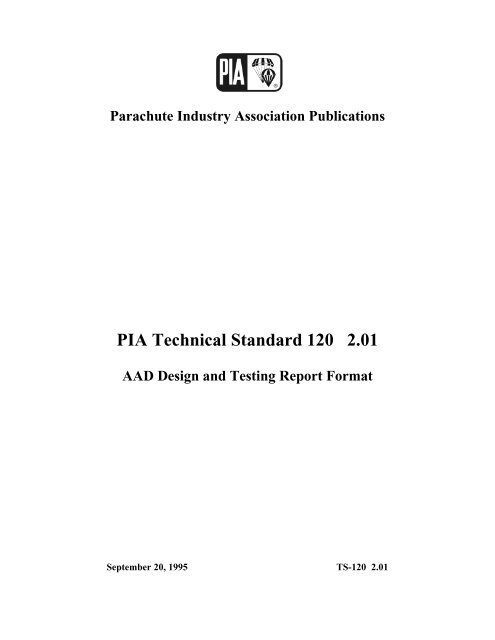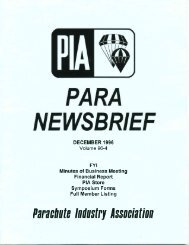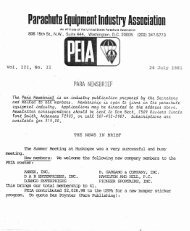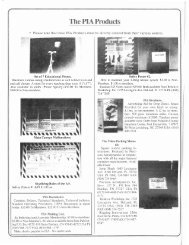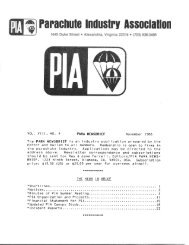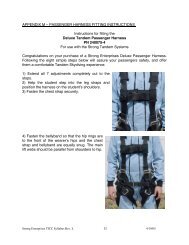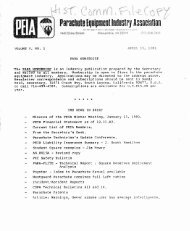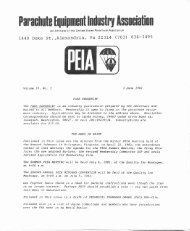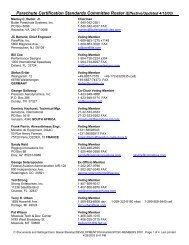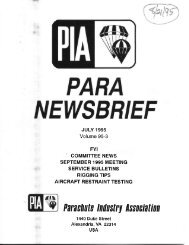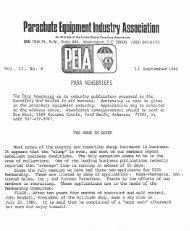TS120 AAD Design and Testing Report Format - Parachute Industry ...
TS120 AAD Design and Testing Report Format - Parachute Industry ...
TS120 AAD Design and Testing Report Format - Parachute Industry ...
You also want an ePaper? Increase the reach of your titles
YUMPU automatically turns print PDFs into web optimized ePapers that Google loves.
<strong>Parachute</strong> <strong>Industry</strong> Association Publications<br />
PIA Technical St<strong>and</strong>ard 120 2.01<br />
<strong>AAD</strong> <strong>Design</strong> <strong>and</strong> <strong>Testing</strong> <strong>Report</strong> <strong>Format</strong><br />
September 20, 1995 TS-120 2.01
Table of Contents<br />
1. Objective..................................................................................................4<br />
2. Reference documents ..............................................................................4<br />
3. <strong>Design</strong> description ...................................................................................5<br />
3.1. Specific usage modes of the device........................................................................... 5<br />
3.2. Principle of operation ............................................................................................... 5<br />
3.3. Technical data........................................................................................................... 5<br />
3.4. Limitations................................................................................................................ 6<br />
3.5. Preventive means of the device to minimize the affection<br />
of system or sub system failures ............................................................................... 6<br />
4. <strong>Testing</strong> .....................................................................................................6<br />
4.1. General overview of the testing program................................................................. 6<br />
4.2. Altitude measurement subsystem............................................................................. 7<br />
4.3. Release subsystem..................................................................................................... 7<br />
4.4. Complete system test ................................................................................................ 7<br />
4.4.1. Installation <strong>and</strong> function .......................................................................................... 7<br />
4.4.2. Drop tests .................................................................................................................. 8<br />
4.4.3. Live jumps ................................................................................................................ 8<br />
4.5. Environmental testing .............................................................................................. 8<br />
4.5.1. Shock......................................................................................................................... 8<br />
4.5.2. Vibration................................................................................................................... 9<br />
4.5.3. Humidity................................................................................................................... 9<br />
4.5.4. Salt ............................................................................................................................ 9<br />
4.5.5. Temperature ........................................................................................................... 10<br />
4.5.6. Software .................................................................................................................. 10<br />
4.5.7. EMI / EMS / ESD ................................................................................................... 11<br />
4.5.8 Aging test ................................................................................................................ 11<br />
4.5.9. Other ....................................................................................................................... 11<br />
PIA Technical St<strong>and</strong>ard 120 2.01 - <strong>AAD</strong> <strong>Design</strong> <strong>and</strong> <strong>Testing</strong> <strong>Report</strong> <strong>Format</strong> September 20, 1995
5. Human Interface ...................................................................................11<br />
5.1. Arm / Disarm .......................................................................................................... 11<br />
5.2. User calibration ...................................................................................................... 11<br />
5.3. Parameter changes.................................................................................................. 12<br />
6. Marking / Labeling................................................................................12<br />
7. Documentation.......................................................................................12<br />
8. Maintenance ..........................................................................................12<br />
8.1. Field maintenance................................................................................................... 12<br />
8.2. Manufacturer maintenance.................................................................................... 12<br />
8.3. Service stations ....................................................................................................... 13<br />
9. Quality Control Procedures/Systems <strong>and</strong> Methodology......................13<br />
9.1. Purchased parts / components................................................................................ 13<br />
9.2. Production............................................................................................................... 13<br />
9.3. Final testing ............................................................................................................ 13<br />
9.4. In the field............................................................................................................... 13<br />
10. Additional remarks ...............................................................................13<br />
PIA Technical St<strong>and</strong>ard 120 2.01 - <strong>AAD</strong> <strong>Design</strong> <strong>and</strong> <strong>Testing</strong> <strong>Report</strong> <strong>Format</strong> September 20, 1995
1. Objective<br />
The PIA <strong>AAD</strong> <strong>Design</strong> & <strong>Testing</strong> <strong>Report</strong> <strong>Format</strong> is regarded as fulfilled when the<br />
manufacturer releases the following test report about his product.<br />
The test report will be published by the PIA in the "Para NewsBrief", <strong>and</strong> on the PIA<br />
Internet Web Site so that the public has access to it.<br />
With the following report procedure, every manufacturer has their own choice to define<br />
the extent <strong>and</strong> kind of requirements concerning their particular unit. The requirement<br />
regarding quality of each product results from the self-defined test requirements. Each<br />
manufacturer is free to decide which of the actual tests <strong>and</strong> quality control parameters they<br />
want to use in the published test report.<br />
The self-chosen quality requirements should be documented.<br />
The form of the description should follow a general format. In each section, the<br />
manufacturer should describe:<br />
- the goal of the test, e.g. recognizing of the correct activation altitude, checking of<br />
correct function under elevated temperatures, etc.<br />
- how many units have been utilized to perform the test in question<br />
- the test arrangement<br />
- what has been measured/tested?<br />
- how has it been measured/tested?<br />
- what test equipment has been utilized?<br />
Each test report shall contain references to all sections, even if they are “not<br />
recommended”. All sections should be listed even when no data is presented. In this case<br />
a statement such as “not applicable”, “not recommended”, “not appropriate”, “not valid”,<br />
or “no statement on this point” should be included. In the event there is no reference to<br />
any particular section, the Para NewsBrief Editor will include the missing section with the<br />
notation “no statement supplied by the manufacturer” prior to publishing the report.<br />
2. Reference documents<br />
MIL-STD-810E<br />
MIL-STD-45662A<br />
RTCA/DO-160C<br />
MIL-STD-331B<br />
RTCA/DO-178B<br />
MIL-STD-461D<br />
Environmental Test Methods<br />
Calibration System Requirements<br />
Environmental Conditions <strong>and</strong> Test Procedures<br />
Procedure C1 for Temp. & Humidity Test<br />
Software considerations in Airborne Systems <strong>and</strong> Equipment<br />
Certifications<br />
Requirements of the Control of Electromagnetic Interference,<br />
Emissions <strong>and</strong> Susceptibility<br />
PIA Technical St<strong>and</strong>ard 120 2.01 - <strong>AAD</strong> <strong>Design</strong> <strong>and</strong> <strong>Testing</strong> <strong>Report</strong> <strong>Format</strong> September 20, 1995
3. <strong>Design</strong> description<br />
3.1. Specific usage modes of the device (recommended)<br />
a description for what purposes the device is suitable (or not suitable) e.g. is the unit<br />
designed for a particular usage, mode of operation, or user-type group (student, t<strong>and</strong>em,<br />
military, etc.)<br />
3.2. Principle of operation (recommended)<br />
a description of how the unit comes to the decision to activate <strong>and</strong> how the life saving<br />
device is activated (in the case of a main or reserve parachute, by what means is the<br />
parachute activated?)<br />
3.3. Technical data (recommended)<br />
Complete technical description including (but not limited to):<br />
- list of components or subsystems<br />
- dimensions<br />
- weight<br />
- volume<br />
- storage conditions<br />
- operating conditions (temp / relative humidity)<br />
- life time of consumptive components (batteries, sensors, filters, springs, antenna,<br />
etc.)<br />
- activation parameters<br />
- accuracy<br />
- reliability (statistical value)<br />
- service interval<br />
3.4. Limitations (recommended if appropriate)<br />
examples:<br />
- if the unit is not suitable for certain parachuting activities<br />
- if the unit is only suitable for specific operations<br />
- if unusual basic operating conditions are required<br />
Typical questions which may arise here:<br />
- Can the unit be used when take-off <strong>and</strong> l<strong>and</strong>ing sites are at different locations or<br />
PIA Technical St<strong>and</strong>ard 120 2.01 - <strong>AAD</strong> <strong>Design</strong> <strong>and</strong> <strong>Testing</strong> <strong>Report</strong> <strong>Format</strong> September 20, 1995
altitudes?<br />
- Can it be used for high altitude jumps?<br />
- Can it be used for water jumps (salt / fresh water)?<br />
- Can it be used when flying in pressurized aircraft?<br />
- Can it be used at extreme speeds?<br />
3.5. Preventive means of the device to minimize the affection of system or sub system<br />
failures (optional)<br />
- means taken to recognize the failure of the whole system<br />
- means taken to recognize the failure of a sub-systems<br />
- is there an indicator for a failure?<br />
- how are these precautions adequate to prevent a misfiring?<br />
4. <strong>Testing</strong><br />
4.1. General overview of the testing program (recommended)<br />
Clear description of the testing system, goals, results, <strong>and</strong> after action.<br />
Note: this section is very important. From the information given here conclusions can be<br />
derived concerning the probability of various problem areas in<br />
- design<br />
- development<br />
- test<br />
- production<br />
- usage<br />
It should be made clear that problems are recognized <strong>and</strong> that solutions lead to results.<br />
The exact details of specific solutions need not necessarily be explained, as often this is<br />
the proprietary knowledge of the particular manufacturer.<br />
PIA Technical St<strong>and</strong>ard 120 2.01 - <strong>AAD</strong> <strong>Design</strong> <strong>and</strong> <strong>Testing</strong> <strong>Report</strong> <strong>Format</strong> September 20, 1995
4.2. Altitude measurement subsystem (recommended)<br />
which procedure is utilized to establish altitude:<br />
- freefall time<br />
- air pressure (barometric)<br />
- air pressure (dynamic)<br />
- gyroscopic navigation<br />
- radio altimetric<br />
- other<br />
which physical tests have been performed to check the function of this subsystem?<br />
what is the functional principle of the measurement apparatus?<br />
which data basis has been used for the functional testing <strong>and</strong>/or simulation?<br />
4.3. Release subsystem (if appropriate)<br />
This section needs to be completed if a main or reserve parachute is used for the life<br />
saving action <strong>and</strong> therefore have to be released. The principle of operation of the<br />
subsystem should be described here with the specific requirements of the tests.<br />
If a completely independent system for the saving action is used, “not applicable” should<br />
be used here.<br />
Include if applicable: Required force of the activation sub system? (i.e. spring pull: what<br />
force has to be achieved?) Are any special materials necessary such as loops, special<br />
closing pins, etc.?<br />
4.4. Complete system test<br />
4.4.1. Installation <strong>and</strong> function (recommended)<br />
Description of how the basic installation in / on a parachute container is performed.<br />
What has been checked to verify proper integration <strong>and</strong> interaction of the parachute<br />
system <strong>and</strong> the <strong>AAD</strong> system?<br />
What has been done to avoid interference with the other portions <strong>and</strong> material of the<br />
parachute system? What particular instructions to users <strong>and</strong> riggers have resulted from<br />
this?<br />
Are any specific materials or tools required, or is there a special "installation service<br />
station"?<br />
PIA Technical St<strong>and</strong>ard 120 2.01 - <strong>AAD</strong> <strong>Design</strong> <strong>and</strong> <strong>Testing</strong> <strong>Report</strong> <strong>Format</strong> September 20, 1995
4.4.2. Drop tests (optional)<br />
How many jumps with how many different units, under which conditions, with which<br />
goals have been performed?<br />
Results could be presented in a simple form (judgment of good, satisfactory, etc.) or in a<br />
more extensive form (tables with measurement results, etc.).<br />
Questions which could be answered by a reasonable number of drop tests are:<br />
- how does the system cope with unstable freefall?<br />
- how does the system react to a cutaway?<br />
- how does the system react to different freefall velocities?<br />
- how does this system react to various stable freefall positions?<br />
4.4.3. Live jumps (optional)<br />
How many live jumps with how many different units, under which conditions, with which<br />
goals have been performed?<br />
Results could be presented in a simple format (judgment of good, satisfactory, etc.) or in<br />
a more extensive form (tables with measurement results, etc.).<br />
Questions which could arise here are:<br />
- is the tests series comprehensive enough?<br />
- were extreme climatic conditions considered?<br />
e.g. how does the system react<br />
4.5. Environmental testing<br />
4.5.1. Shock (recommended)<br />
- to strong thunderstorms?<br />
- to high humidity?<br />
- to high / low temperatures?<br />
Refer to the comprehensive procedures in:<br />
MIL-STD-810E Environmental Test Methods, Method 516.4<br />
RTCA/DO-160C Environmental Conditions <strong>and</strong> Test Procedures, Section 7<br />
It is highly desirable that the tests are performed in accordance with these or similar<br />
procedures<br />
The report should include a description of the procedures <strong>and</strong> the results.<br />
PIA Technical St<strong>and</strong>ard 120 2.01 - <strong>AAD</strong> <strong>Design</strong> <strong>and</strong> <strong>Testing</strong> <strong>Report</strong> <strong>Format</strong> September 20, 1995
4.5.2. Vibration (recommended)<br />
Refer to the comprehensive procedures in:<br />
MIL-STD-810E Environmental Test Methods, Method 514.4<br />
RTCA/DO-160C Environmental Conditions <strong>and</strong> Test Procedures, Section 8<br />
It is highly desirable that the tests are performed in accordance with these or similar<br />
procedures<br />
The report should include a description of the procedures <strong>and</strong> the results.<br />
4.5.3. Humidity (recommended if appropriate)<br />
Note: if in section 3.3 specific humidity rangers are not excluded, some consideration<br />
should be given here in regard to condensing / not condensing, rain, submersion, etc.<br />
Refer to the comprehensive procedures in:<br />
MIL-STD-810E Environmental Test Methods, Method 507.3, 508.4, 506.3,<br />
520.1<br />
RTCA/DO-160C Environmental Conditions <strong>and</strong> Test Procedures, Section 6, 10,<br />
24<br />
MIL-STD-331B Procedure C1 for Temp. & Humidity Test<br />
It is highly desirable that the tests are performed in accordance with these or similar<br />
procedures<br />
The report should include a description of the procedures <strong>and</strong> the results.<br />
4.5.4. Salt (recommended if appropriate)<br />
Refer to the comprehensive procedures in:<br />
MIL-STD-810E Environmental Test Methods, Method 509.3<br />
RTCA/DO-160C Environmental Conditions <strong>and</strong> Test Procedures, Section 14, 24<br />
MIL-STD-331B<br />
Procedure C1 for Temp. & Humidity Test<br />
It is highly desirable that the tests are performed in accordance with these or similar<br />
procedures<br />
The report should include a description of the procedures <strong>and</strong> the results.<br />
PIA Technical St<strong>and</strong>ard 120 2.01 - <strong>AAD</strong> <strong>Design</strong> <strong>and</strong> <strong>Testing</strong> <strong>Report</strong> <strong>Format</strong> September 20, 1995
4.5.5. Temperature (recommended)<br />
<strong>Testing</strong> should be performed at least in the range which is defined in section 3.3. as<br />
allowed<br />
Refer to the comprehensive procedures in:<br />
MIL-STD-810E Environmental Test Methods, Method 501.3 ... 503.3, 520.1<br />
RTCA/DO-160C Environmental Conditions <strong>and</strong> Test Procedures, Section 4, 5, 24<br />
It is highly desirable that the tests are performed in accordance with these or similar<br />
procedures<br />
It is important to know if a classification according RTCA/DO-160C had been made<br />
The report should include a description of the procedures <strong>and</strong> the results<br />
4.5.6. Software (recommended if appropriate)<br />
Corresponding portions of RTCA/DO 178B<br />
In which software level (A ... E) has the software been classified<br />
Description of the quality control methodology used in<br />
- software design (RTCA/DO 178B, chapter 4.1 ... 4.6)<br />
- software programming (RTCA/DO 178B, chapter 5.1 ... 5.5)<br />
- software testing (RTCA/DO 178B, chapter 6.1 ... 6.4)<br />
- software documentation<br />
- software validation (RTCA/DO 178B, chapter 9.1 ... 9.4)<br />
- software controls during production phase (RTCA/DO 178B, chapter 7.1 ... 7.3)<br />
- software design change testing <strong>and</strong> validation (RTCA/DO 178B,<br />
chapter 11.1 ... 11.20)<br />
to achieve the desired quality level<br />
4.5.7. EMI / EMS / ESD (recommended if appropriate)<br />
corresponding portions of MIL-STD-461D <strong>and</strong> RTCA/DO-160C,<br />
section 15 <strong>and</strong> 19 ... 22)<br />
With electronic units it should be assumed that the electromagnetic environment is<br />
extremely aggressive. At the same time consideration should be made to possible<br />
interference with airborne avionics.<br />
In particular, the points to be considered are:<br />
- passive susceptibility (radiated, conducted, electrostatic)<br />
PIA Technical St<strong>and</strong>ard 120 2.01 - <strong>AAD</strong> <strong>Design</strong> <strong>and</strong> <strong>Testing</strong> <strong>Report</strong> <strong>Format</strong> September 20, 1995
- active radiation<br />
Which portions of the spectrum at what power levels have been tested? Which<br />
frequencies in particular have been tested separately?<br />
- magnetic<br />
- electro magnetic<br />
What electrostatic discharge levels is the unit compatible with at various entry points?<br />
4.5.8 Aging test (optional)<br />
What tests have been conducted with which results in order to formulate a statement<br />
about the expected life time of the unit?<br />
Refer to the procedures in MIL-STD-331B, Procedure C1<br />
4.5.9. Other (optional)<br />
e.g. environmental test for s<strong>and</strong> <strong>and</strong> dust, see RTCA/DO-160C, Section 12<br />
5. Human Interface<br />
5.1. Arm / Disarm (recommended if appropriate)<br />
How, when, where is the unit to be armed / disarmed? (An excerpt from the Operation<br />
Instructions could be useful here.)<br />
5.2. User calibration (recommended if appropriate)<br />
Description of when <strong>and</strong> how the unit needs to be calibrated? (An excerpt from the<br />
Operation Instructions could be useful here.)<br />
5.3. Parameter changes (recommended if appropriate)<br />
Description of how particular functioning parameters can be changed, if possible. For<br />
instance: Setting / changing of:<br />
- activation altitude<br />
- activation velocity<br />
- freefall time<br />
- activation delay<br />
- (other)<br />
PIA Technical St<strong>and</strong>ard 120 2.01 - <strong>AAD</strong> <strong>Design</strong> <strong>and</strong> <strong>Testing</strong> <strong>Report</strong> <strong>Format</strong> September 20, 1995
6. Marking / Labeling (recommended)<br />
Description of the unit marking <strong>and</strong> labeling. At minimum, samples should be presented<br />
along with a description of the various portions. (Serial number, part number, date of<br />
manufacture, etc.)<br />
7. Documentation (recommended)<br />
- copy of Operator’s manual / user documentation<br />
- copy of any installation / rigging instructions or documentation<br />
- (optional), copy of any servicing documentation<br />
- complete list of available documentation<br />
- list of languages in which these documents are available<br />
8. Maintenance<br />
8.1. Field maintenance (recommended if appropriate)<br />
description of periodic inspection or testing which can or must be made “in the field”.<br />
(at every repack, after contact with water, etc.)<br />
8.2. Manufacturer maintenance (recommended if appropriate)<br />
- periodic maintenance cycle<br />
- other times factory maintenance required: after specific conditions, mis-use, etc.<br />
- (optional), what are the specific procedures, what is replaced, how long does the<br />
maintenance procedure take, what are the estimated costs?<br />
8.3. Service stations (recommended if appropriate)<br />
which maintenance procedures can be performed at (factory authorized) service stations?<br />
(optional) list of factory authorized service stations<br />
PIA Technical St<strong>and</strong>ard 120 2.01 - <strong>AAD</strong> <strong>Design</strong> <strong>and</strong> <strong>Testing</strong> <strong>Report</strong> <strong>Format</strong> September 20, 1995
9. Quality Control Procedures/Systems <strong>and</strong> Methodology<br />
9.1. Purchased parts / components (optional)<br />
- are all part suppliers ISO 9000 certificated?<br />
- are the components used of: consumer, industrial, military, or other grade/quality<br />
specification?<br />
9.2. Production (optional)<br />
- is the manufacturer ISO 9000 certificated?<br />
- are subcontractors ISO 9000 certificated?<br />
- is a quality control manual available?<br />
- is the quality of every unit recorded?<br />
9.3. Final testing (optional)<br />
- is 100% or statistical sampling tests performed? (what sampling method?)<br />
- what is being tested in detail?<br />
- describe any tests performed that ensure each unit produced meets the performance<br />
st<strong>and</strong>ards of the original design.<br />
- what testing records are retained for each unit?<br />
9.4. In the field (optional)<br />
What means are available to monitor or control the quality in the field? (Capability of<br />
functioning, precision, accuracy, etc.)<br />
10. Additional remarks<br />
Any additional items that the manufacturer wishes to disclose concerning the unit<br />
(background, operation, usage, testing, etc.).<br />
PIA Technical St<strong>and</strong>ard 120 2.01 - <strong>AAD</strong> <strong>Design</strong> <strong>and</strong> <strong>Testing</strong> <strong>Report</strong> <strong>Format</strong> September 20, 1995


